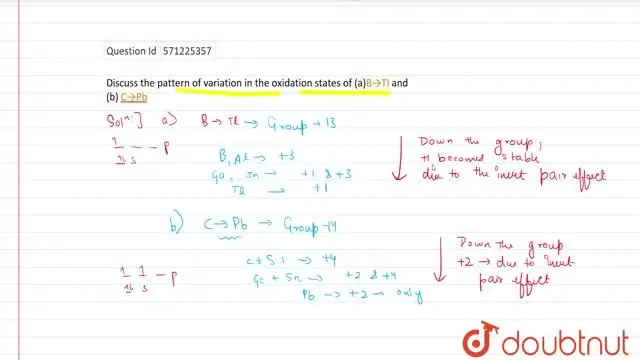Discuss the pattern of variation in the oxidation states of (a)B→TI and (b) C→Pb.
(i) B to TI
The electric configuration of group 13 elements is ns2 np1. Therefore, the most common oxidation state exhibited by them should be +3. However, it is only boron and aluminium which practically show the +3 oxidation state. The remaining elements, i.e., Ga, In, Tl, show both the +1 and +3 oxidation states. On moving down the group, the +1 state bocmes more stable. For example, Tl (+1) is more stable than Tl(+3). This is because of the inert pair effect. The two electrons present in the s-shell are strongly attracted by the nucleus and do not participate in bonding. This inert effect becomes more and more prominent on moving down the group. Hence, Ga (+1) is unstable, In (+1) is fairly stable, and Tl (+1) is very stable.
Group 13 elementOxidation stateB+3Al+3Ga,In,Tl+1,+3
The stability of the +3 oxidation state decreases on moving down the group.
(ii) C to Pb
The electronic configuration of group 14 elements is ns2 np2. Therefore, the most common oxidation state exhibited by them should be +4. However, the +2 oxidation state becomes more and more common on moving down the group. C and Si mostly show the +4 state. On moving down the group, the higher oxidation state becomes less stable. This is because of the inert pair effect. Thus, although Ge, Sn, and Pb show both the +2 and +4 states, the stability of the lower oxidation state increases and that of the higher oxidation state decreases on moving down the group.
Group 14 elementOxidation stateC+4Si+4Ge,Sn,Pb+2,+4
stability of +2 state increases−−−−−−−−−−−−−−−−→
C Si Ge Sn Pb−−−−−−−−−−−−−−−−−→stability of +4 state decreases
Related Playlists
Similar Questions
Predict the highest and lowest oxidation state of (a) Ti and (b) Tl
View SolutionAmong the following elements, what is the total number of elements having the lowest oxidation state of zero? <br>Ta
b.Te
c. Tc
d. Ti
e. TIView SolutionOxidation state of nitrogen in H−N≡C is
View SolutionDiscuss the properties of group 13 elements with reference to oxidation states
View SolutionName the following:
(a) A transition metal which does not exhibit variation in oxidation state in its compounds.
(b) A compound where the transition metal is the +7 oxidation state.
(c) A member of the lanthanoid series which is well known to exhibit +4 oxidation state.
(d) Ore used in the preparation of Potassium dichromate.View SolutionWhat is the covalency of B in [B(OH)4] and its oxidation state ?
View SolutionElements of group 14
(a) exhibit oxidation state of +4 only
(b) exhibit oxidation state of +2 and +4
(c) form M2– and M4+ ions
(d) form M2+ and M4+ ionsView SolutionA compound contains three elements A,B and C, if the oxidation number of A=+2B=+5 and C=−2 then possible formula of the compound is
View SolutionWhat is the physical state of water at: a. 250∘C b. 100∘C?
View Solution(i) A powdered substance (A) on treatment with fusion mixture gives a green coloured compound (B). (ii) The solution of (B) in boiling water on acidification with dilute H2SO4 gives a pink coloured compound (C).
The oxidation state of central metal ions of (A), (B) and (C ) compounds are respectively :View Solution


